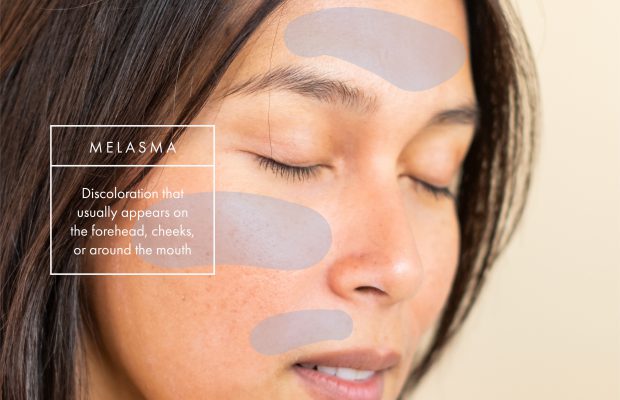Updated 04/05/23. Whether you call it pregnancy mask, discoloration, brown patches, or a “mustache,” melasma is a common skin condition that affects around six million women in the United States. Even though it’s common, melasma can be tricky to identify and even trickier to remove. Keep reading to learn all about it, including how to address it with skincare and how to tell the difference between melasma and other types of pigmentation.
What Is Melasma and What Causes It?
Melasma is a pigmentation disorder characterized by brown or gray-brown patches on the skin. You can develop melasma anywhere. However, it most commonly appears in sun-exposed regions, like on the forehead, around the mouth (especially on the upper lip), and along the outer perimeters of the face.
Melasma is essentially an overproduction of a pigment called melanin. Melanin is produced by skin cells called melanocytes, which live in the dermis (the deepest layer of the skin). As melanocytes produce melanin, it gets bundled up into melanosomes, which move up to the surface of the skin and disperse. This is what causes the uneven color to appear on the skin.
No one is quite sure of what causes melasma, but there are a few well-known triggers and it’s usually a combination of them. Genetics and hormones are the most common, which is why it’s often associated with pregnancy, but other possibilities include UV exposure and skin irritation. While it poses no medical risk, it is bothersome to some people who have it—especially because it can be so stubborn to manage. Once the melanin factory turns on, it can be hard to calm fussy pigment cells back down.
Who Can Get Melasma?
While technically anyone can get melasma, some of us are more prone to it than others.
- Women: Women’s hormones stay quite active throughout adulthood, whereas men’s hormones tend to calm down after adolescence. Since hormonal fluctuations are a common trigger for melasma, women are far more prone to it than men. In fact, a whopping 90 percent of melasma cases occur in women!
- Those Who Are Pregnant: Few hormonal fluctuations are as intense as those that happen throughout pregnancy. Because of this, many women experience melasma during this time. That explains why it’s so often referred to as a “pregnancy mask.”
- Those Who Use Hormonal Birth Control: Many hormonal birth control methods essentially mimic a state of pregnancy in the body. That explains why prolonged use of these hormonal birth control methods can trigger melasma. Learn more about how birth control affects the skin.
- Those Who Have Deeper Skin Tones: As I mentioned before, melasma stems from an overproduction of a pigment called melanin. Those who have deeper skin tones have more active melanocytes than those who have lighter skin tones, so it’s easier for them to become overstimulated.
- Those Who Are Genetically Predisposed: If one of your immediate relatives has melasma, you’re more likely to develop it.
How Can I Tell the Difference Between Melasma and Hyperpigmentation?
Melasma is one of four types of hyperpigmentation, which itself is defined as the overproduction of pigment in the skin.
- Melasma: Large, dark brown and/or grayish patches that usually appear on the forehead, cheeks, or around the mouth.
- Post-Inflammatory Hyperpigmentation (PIH): Small, individual dark spots that are left over from trauma to the skin, whether that was a blemish, bug bite, cut, or scratch. To fade PIH, I love the Post-Breakout Fading Gel.
- Age/Sun Spots: Flat spots that range from light brown to dark brown in color. These are mainly caused by sun exposure.
- Freckles: Small brown spots brought on during childhood—a genetic condition.
How can you tell if you’re dealing with melasma or one of the other three types of hyperpigmentation? If you suspect you have melasma, it’s best to confirm it by seeing a dermatologist. In the meantime, though, there is a simple test you can do at home. Here’s how.
Start by cleansing your hands and face. Then, in a well-lit room, gently stretch the area of the face that appears discolored. If the skin appears lighter when stretched, the pigmentation is close to the surface and most likely superficial in nature. This means it’s most likely NOT melasma. If the skin appears darker when stretched, the pigmentation lies deep in the layers of the skin and will be more challenging to address. In this case, it’s more likely to be melasma than any of the other types of hyperpigmentation.
What Are the Best Ways to Get Rid of Melasma?
While it’s certainly possible to get rid of melasma in some instances, that’s not always the case. Melasma is very complex and occurs deep within the skin, which means it can be really difficult to get rid of. Success depends on an individual’s skin type and tolerance, and more importantly, how dedicated he or she is to improve it. Even if you do get rid of your melasma completely, there’s a good chance you’ll have to continue treatment, since it can easily creep back up if you’re not staying on top of it.
Here are expert-approved ways to target melasma, split up into three categories—lifestyle changes, at-home products, and professional treatments.
Lifestyle Changes
There are definitely things you can do at home and in-office to treat melasma. First, though, it’s important to know that lifestyle changes must be made in order for these treatments to be successful.
Avoid Sun Exposure
This is hands down the most important thing you can do to keep pigment cells calm. There is increasing evidence that melasma is a photoaging skin disorder, making UV exposure a critical trigger of melasma. Stay out of the sun when possible and wear a generous amount of sunscreen daily. Sunscreen is a MUST 365 days a year, as just one day in the sun can trigger a melasma cascade if you are pre-disposed to it. Hats, sunglasses, and sun-protective clothing are also your best defense.
Reduce Heat Exposure
For years, it was thought that UV exposure was the only thing that increased pigmentation. We now know that heat also increases pigmentation by exciting melanocyte activity. Heat from saunas, steam rooms, exercise (particularly hot yoga), and face coverings all increase the skin’s internal temperature. Be aware of this and try your best to reduce your exposure to heat as much as possible if you’re serious about reducing melasma.
Consider Your Birth Control
If your melasma appeared after going on hormonal birth control, you can discuss an alternative with your doctor.
At-Home Products
Depending on the severity of your melasma, you may be able to get it under control by using at-home products only. Either way, being diligent about your daily routine is a crucial step in getting melasma under control to avoid relapse, which is common. Consider multiple approaches to your routine as melasma can have multiple root causes and may not respond to just one thing.
Topical Pigment Inhibitors
Look for products with ingredients that will block tyrosinase. This will help interrupt signals sent to melanocytes. These ingredients include hydroquinone, azelaic acid, kojic acid, arbutin, licorice extract, and vitamin C. There is a lot of research showing the effectiveness of topical vitamin C so be sure to invest in a well-formulated serum. (I like using THD Ascorbate to avoid getting a “vitamin C acid burn”.)
Note: If you opt to use hydroquinone, I recommend using at least a four percent strength formula, which is usually available in a prescription cream. Hydroquinone is particularly effective when combined with tretinoin (vitamin A) and a topical steroid, as found in Tri-Luma. Make sure you introduce prescriptions slowly, as they can trigger irritation and dryness. Make sure you’re also doing everything you can to keep your skin’s moisture barrier intact. Talk to your doctor about how long a prescription should be used. If used too long, patients can develop ochronosis, which is a dark, blue-black pigmentation that’s hard to get rid of.
Exfoliants
Exfoliation is important because it helps lift visible pigmentation off the skin. I like glycolic and salicylic acid for this purpose. Fruit enzymes, such as papaya or pineapple, are also great options and are more gentle than exfoliating acids. Even though it isn’t technically an exfoliant, retinol is also an option, because it increases cell turnover. This will bring pigmentation to the surface (where it can be sloughed off by exfoliants) more quickly. Pro Results Power Serum is my go-to recommendation for those with melasma. Finally, I do recommend a physical exfoliating scrub for pigmentation. Read why, here.
Makeup
I think of makeup as a form of skincare in that it provides a protective barrier for your skin (read more about that in this post). When it comes to melasma, it can also help conceal and color correct to make pigmentation less noticeable. It can be tricky to neutralize melasma with makeup, so I suggest consulting a skilled makeup artist. They will help you determine the best makeup techniques for you and your skin.
Cooling Products
As I said before, heat can trigger pigmentation, and that includes melasma. If you are exposed to heat, try using something simple, such as ice cubes or frozen peas, to quickly cool your skin. You can also try keeping certain skincare products, like toners and gel-based masques, in the fridge for an extra cooling effect. While outside, apply ice or a cool compress to the back of your neck to prevent your internal temperature from rising too much.
Professional Treatments
How often you should get professional treatments will vary from person to person. It’s important to consult an experienced provider who can tailor a treatment plan to you and your specific needs. There is no black-and-white answer as to how long it takes to get rid of melasma. However, if you’re diligently addressing it through lifestyle changes, at-home products, and professional treatments, you can probably expect noticeable improvements within three months. Here are a few professional treatments that can help. Consult a dermatologist to find out which one is best for you and your melasma.
Chemical Peels
A series of chemical peels (using salicylic, lactic, or glycolic acids) can break up pigment cells that have risen to the surface of the skin. For a stronger treatment, you can inquire about getting a Jessner’s Peel, which includes salicylic and lactic acids, as well as a resorcinol solution to provide deeper exfoliation.
No-Heat Laser
Many people have had excellent success in removing unwanted pigment through laser treatments. This is because lasers can penetrate into the deeper layers of the skin where melasma is formed. Consult a skin professional to find out which one is best suited for you and your skin.
Note: Winter is actually the best time of year to have these professional treatments done. Since winter means less heat and sun exposure, you’re less likely to be exposed to melasma triggers. This means the results of your treatment will last longer.
What’s the Bottom Line?
Melasma is an incredibly complex and challenging condition that requires constant care. It can’t always be removed completely, but there are many things you can do to keep it in check. Remember, patience is key. The pigment was forming in the skin long before it made its way to the surface, so it’s not just going to disappear overnight. It can take months, even longer, to address it, but if you stay dedicated, you will see results!
Next, learn how to prevent summer sun spots from forming.
Celebrity Esthetician & Skincare Expert
As an esthetician trained in cosmetic chemistry, Renée Rouleau has spent 35 years researching skin, educating her audience, and building an award-winning line of products. Her hands-on experience as an esthetician and trusted skin care expert has created a real-world solution — products that are formulated for nine different types of skin so your face will get exactly what it needs to look and feel its best. Trusted by celebrities, editors, bloggers, and skincare obsessives around the globe, her vast real-world knowledge and constant research are why Marie Claire calls her “the most passionate skin practitioner we know.”



